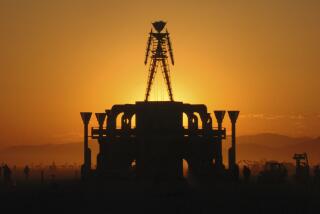Despite rebuke, panel supports Smithsonian official who pulled video
- Share via
Reporting from Washington — A panel advising the Smithsonian Institution on how to handle controversies that may spring from its exhibitions — such as Secretary G. Wayne Clough’s decision to pull a video from the National Portrait Gallery — moved Monday to prevent the removal of any artwork from museum shows without wide consultation.
The recommendation was seen as a rebuke to Clough, who decided to pull the video “A Fire in My Belly” by David Wojnarowicz from the exhibition “Hide/Seek: Difference and Desire in American Portraiture” after House Republican leaders, whose support is key to the Smithsonian’s funding, called it sacrilegious.
The removal was called censorship by artists and museum officials, and the Andy Warhol Foundation for the Visual Arts pledged to stop funding Smithsonian exhibitions if the video were not restored.
But John W. McCarter Jr., president and chief executive officer of the Field Museum in Chicago and chairman of the panel, said that Clough enjoyed “enormous support” from the Smithsonian’s board of regents and that there was no discussion of firing him.
The panel, in its recommendations to the board of regents, said the Smithsonian had an “obligation to produce exhibitions that may be controversial,” but it said that “in the absence of actual error, changes to exhibitions should not be made once an exhibition opens without meaningful consultation” with the leadership of the regents, among others. Officials noted that the board included members of Congress.
Patricia Q. Stonesifer, the board’s chairwoman, said that regents watched the video, with its sequence showing ants crawling over a crucifix, but did not vote on whether it should have been removed. McCarter said in response to a question that he thought including the video in the exhibition had been the right decision.
“We’re in the business of often doing exhibits that are about flashpoints in American history, flashpoints in global culture,” Stonesifer said. “We have to accept that with that responsibility comes some controversy.
“Would we wish the whole incident hadn’t happened? Certainly,” Stonesifer said, adding that Clough made a “judgment call.”
In a six-page report available on the Smithsonian’s website, the panel recommended that the institution seek to be “fully informed about red flags before exhibitions go public.”
“We must make sure we do not act abruptly or prematurely, but we are responsive to the kind of immediate reactions that are now possible with social media and the Internet,” McCarter said, calling attention to a recommendation that topics on the national agenda such as race and ethnicity, religion, climate change and sexual identity are “within the scope of the Smithsonian curriculum and should lead to informed civic discourse.”
“I think we learned from this experience,” Clough said.
More to Read
The biggest entertainment stories
Get our big stories about Hollywood, film, television, music, arts, culture and more right in your inbox as soon as they publish.
You may occasionally receive promotional content from the Los Angeles Times.









